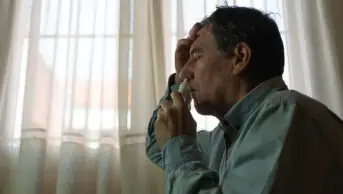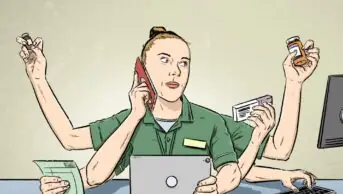
Lindsay Smith
What is your background since graduation?
After my pre-registration year in hospital training, I completed three years at two different hospitals, including Worcestershire Royal Hospital, while undertaking my clinical diploma at the University of Bath. I then completed my prescribing qualification while working as a respiratory specialist.
In 2010, I was seconded to work in a medical assessment unit (MAU) and accident and emergency (A&E) for a year as part of a pilot scheme to help older people in the emergency care setting. I worked with a multidisciplinary team to enable this group of patients to be discharged into the community sooner or prevent admission to hospital altogether.
From this role, I applied for the position of lead pharmacist for the MAU where I worked until I began the task of developing an A&E clinical pharmacy service.
Why did you decide to start working as a pharmacist in A&E?
The initial pilot work indicated that it was beneficial for pharmacists to work in A&E. With my previous experience in the department it was a natural progression for me to move away from medical admissions and to help develop an A&E-specific clinical pharmacy service.
This service tries to prevent attendances becoming admissions and to facilitate the timely discharge of all patients, especially the elderly, from A&E. I examine whether medication could be a potential or actual cause of attendance in A&E and ensure patients are appropriately counselled on their medicines to prevent re-attendance. My team, which currently consists of four pharmacists and two pharmacy technicians, gives this information to the local clinical commissioning group. This helps to direct medicines reviews in primary care which has the potential to prevent future attendances. We also provide an early clinical pharmacy service to those patients waiting to be admitted. The service ensures that medicines reconciliation and clinical interventions are completed as quickly as possible.
This dynamic approach to clinical pharmacy attracted me to the role and I was keen to be involved in its development.
Have you had any special training for the role?
I have received no specific training but my time working in admissions in the MAU has given me a good understanding of the admissions process. Since starting the role I have completed a master’s module in clinical health assessment and I am currently sitting a module in clinical diagnostics and investigations. Both of these modules are run by the University of Warwick for multidisciplinary advanced clinical practitioners. The course will provide me with the extra skills I need to consider how the role of pharmacists can be expanded within the emergency care setting. I have also been involved in the initial stages of the pilot of pharmacists in A&E that is currently running nationally.
Do you believe that pharmacists are adequately trained to assess risk in A&E?
A&E is not a career choice for every pharmacist, in the same way that it is not a career choice for every doctor. Some, like me, thrive on the diverse nature of the role and the potential to expand and seek new ways of working. My career in hospital-based clinical pharmacy and my prescribing qualification have given me a grounding in how to manage the risks associated with my role.
The benefit of working in A&E is that you are not a sole practitioner. Unlike other areas, there is always a group of experienced clinicians to support you, including consultants and specialist nurses. A&E is an excellent learning environment and understanding how the rest of the hospital works around A&E enables me to help my team and other A&E clinicians navigate the local NHS service.
What are your everyday responsibilities?
I have to respond to the needs of the department which can differ vastly from day to day.
I work with the A&E clinicians, reviewing patients who have potential issues with their medicines. These include patients who are aged over 70 years and are taking three or more medicines, patients on high risk medicines, such as warfarin, and patients who have acute or chronic renal impairment. For these patients I identify medicines-related causes of their attendance and provide advice on how these patients can be managed. This may be achieved in the community, for example, by referring to a chronic obstructive pulmonary disease outreach team or a rapid response team.
I also work with the specialist teams and identify patients waiting to be admitted to the wards. Our team does not deal directly with admissions to the wards. Instead, it is responsible for supporting the clerking clinicians in obtaining primary medicines histories and ensuring patients’ medicines are handled appropriately while they wait to be admitted. For example, I may organise prescriptions for intravenous insulin infusion and accompanying fluids for patients with diabetes who are nil by mouth awaiting surgery or prescribe regular dopamine agonists for Parkinson’s disease patients.
Patients are given personalised counselling, which may involve signposting them back to the appropriate service for repeat prescriptions or giving them advice about what to do if their symptoms do not resolve.
I spend a proportion of my day communicating with primary care services such as GPs, community pharmacies and care homes and recording the work I do.
What are some of the job’s highlights and challenges?
Working with team members who are willing to try new ways of working and undertaking the health assessment course, including learning venepuncture and life support, have been highlights for me. I also like feeling that I have made a difference when I help a patient be cared for at home rather than being admitted to hospital, and receiving appreciation from the nursing staff and clinicians when I provide the help they need.
The biggest challenge has been setting up the service initially and organising seven-day working rotas, because this type of work was new to me. Changing the opinions of clinicians whose only experience of pharmacy is at the end of a phone questioning a prescribing error has also been challenging.
We have had to start from the basics and work to prove the worth of the service. We now need to look ahead to think about how we can take the service forward and this will also present its own challenges.


